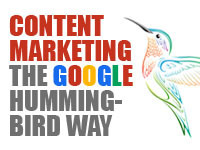 Stiles Says: Bye bye commoditized, low-ball blog farms. Google learned your crap is just crap.
Stiles Says: Bye bye commoditized, low-ball blog farms. Google learned your crap is just crap.

For a bit of fun, say 'Tottenham Hotspur'. Google will search for the greatest team in the world (guest opinion - Ed), and then read out an up to date fact, perhaps the latest result and information about the next match.
Next, click the microphone again and ask a related question, such as 'how old are they?' Google will then show you the Wikipedia information about the club. Ask another question, such as 'where do they play?' and Google will show you information about White Hart Lane.
So, that is Hummingbird in a nutshell - a clever way of linking queries so that, instead of starting each search from scratch, Google can show you more pertinent information related to your previous search.
How does Hummingbird relate to content marketing?
Linking searches in this way turns the search experience into more of a conversation. You shouldn't require a degree in astro-physics to work out where this is going to go. The search engine will soon be able to predict what we want before we know to ask it. That's where the connection to content marketing comes in.
Think about it. If someone has landed on your website having searched for something, there's a strong chance they will have another query that needs answering. Online content publishing has evolved radically, due to a number of factors.
There used to be a trend for creating endless articles full of repeated keywords because Google would reward sites with lots of fresh content and because the repeated use of keywords would help rankings.
That changed when Google decided that too much of the stuff reaching the top of the results lacked substance or any genuine value. Recently, the trend has been to produce more long-form content, where more information can be included in one article. Some long-form articles are long enough to be ebooks.
Now, Hummingbird should make us all re-think about the way we plan and write content. There's an excellent logic to it and, applied properly, websites should be better for it.
Understanding intent is the key to thinking like Hummingbird
In a nutshell, think about why people are looking for something rather than what they are looking for. A content strategy should be designed to answer their needs, not just provide them with facts.
Hummingbird links different websites together to answer questions, but if you follow the same logic, you can plan a chain of connected pieces of information on your website.
Let's use white goods as an example, specifically washing machines. A retailer might feature a range of washing machines, with images and specifications and that might be that, but there are several things a buyer might want to know at different stages of the sales cycle.
Here are some examples of content that could match the intent of these users.

Top of the funnel: just looking for information
- How do washing machines work?
- What's the difference between bio and non-bio washing?
- How much electricity do washing machines use?
- Which washing machines are made in the UK?
- Does hard water damage washing machines?
Middle of the funnel: shopping around, exploring options
- Top washing machine brands compared
- What different functions are available on washing machines?
- Which washing machines are most energy efficient?
- How long does the average wash cycle take?
- What's the best detergent to use in a washing machine?
Bottom of the funnel: ready to buy, comparing retailers and prices
- What delivery and installation options are available?
- What do customer reviews say about xxxxxxx?
- How easy is it to install?
- How noisy is it - in comparison with other machines?
- Compare prices
After sales care: information for customers
- How does the guarantee work? Do you fix it on site?
- Do I need to keep checking the filter?
- Help with the program - it seems to have an error
- Why is powder collecting in the detergent tray?
- Which program is best for different washes?
Now you need to connect it all together
Following the Hummingbird mentality, you need to connect dots for the user with a logical process.
If they want to know one thing, there may be other relating things or follow-on questions they want answers to. Any one of the ideas above could be broken down into a series of helpful articles, or link to video guides or instructographics.
The key is to avoid dead ends but also to avoid making the user have to hunt around to find the answers. You don't want to break it down so much that they feel they are being led through a labyrinth with a never-ending array of answers. Your aim is to solve their problem, but sometimes you can't solve everyone's problem on one page.
Think about how different pieces of information can be linked together so that users can find these related articles in a way that is easy to navigate. Information architecture is a skill in itself.
How does this all help with content marketing?
So, you have used the Hummingbird mentality to create content that answers natural questions in a way that covers all the bases. What this should give you is two things, depending on how it is all published.
First, you should be better placed to benefit from search results, because you have content that answers specific, niche questions. Second, such helpful content is the kind of stuff that customers might share socially and in forums, such as Ask Yahoo!, when they want to be helpful to others.
This article was co-written with Steve MastersThe full scoop is here
Follow us @brandcontentst



